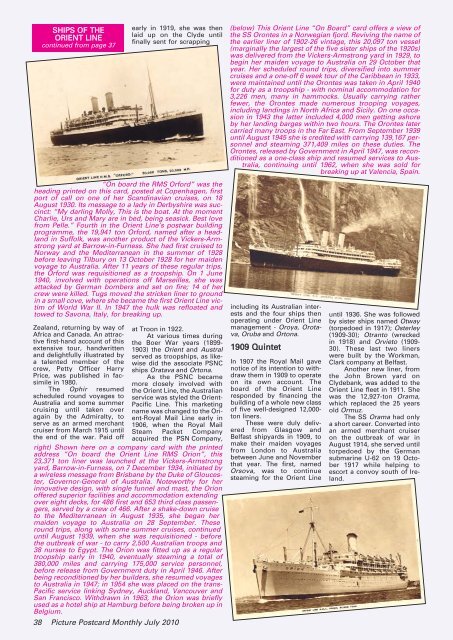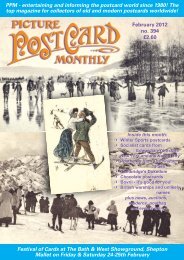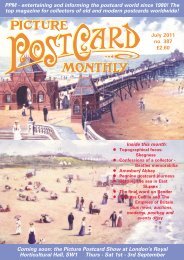PPM revisits Manchester's Belle Vue amusement park - Picture ...
PPM revisits Manchester's Belle Vue amusement park - Picture ...
PPM revisits Manchester's Belle Vue amusement park - Picture ...
You also want an ePaper? Increase the reach of your titles
YUMPU automatically turns print PDFs into web optimized ePapers that Google loves.
SHIPS OF THE<br />
ORIENT LINE<br />
continued from page 37<br />
early in 1919, she was then<br />
laid up on the Clyde until<br />
finally sent for scrapping<br />
“On board the RMS Orford” was the<br />
heading printed on this card, posted at Copenhagen, first<br />
port of call on one of her Scandinavian cruises, on 18<br />
August 1930. Its message to a lady in Derbyshire was succinct:<br />
“My darling Molly, This is the boat. At the moment<br />
Charlie, Urs and Mary are in bed, being seasick. Best love<br />
from Pelle.” Fourth in the Orient Line’s postwar building<br />
programme, the 19,941 ton Orford, named after a headland<br />
in Suffolk, was another product of the Vickers-Armstrong<br />
yard at Barrow-in-Furness. She had first cruised to<br />
Norway and the Mediterranean in the summer of 1928<br />
before leaving Tilbury on 13 October 1928 for her maiden<br />
voyage to Australia. After 11 years of these regular trips,<br />
the Orford was requisitioned as a troopship. On 1 June<br />
1940, involved with operations off Marseilles, she was<br />
attacked by German bombers and set on fire; 14 of her<br />
crew were killed. Tugs moved the stricken liner to ground<br />
in a small cove, where she became the first Orient Line victim<br />
of World War II. In 1947 the hulk was refloated and<br />
towed to Savona, Italy, for breaking up.<br />
Zealand, returning by way of<br />
Africa and Canada. An attractive<br />
first-hand account of this<br />
extensive tour, handwritten<br />
and delightfully illustrated by<br />
a talented member of the<br />
crew, Petty Officer Harry<br />
Price, was published in facsimile<br />
in 1980.<br />
The Ophir resumed<br />
scheduled round voyages to<br />
Australia and some summer<br />
cruising until taken over<br />
again by the Admiralty, to<br />
serve as an armed merchant<br />
cruiser from March 1915 until<br />
the end of the war. Paid off<br />
at Troon in 1922.<br />
At various times during<br />
the Boer War years (1899-<br />
1903) the Orient and Austral<br />
served as troopships, as likewise<br />
did the associate PSNC<br />
ships Oratava and Ortona.<br />
As the PSNC became<br />
more closely involved with<br />
the Orient Line, the Australian<br />
service was styled the Orient-<br />
Pacific Line. This marketing<br />
name was changed to the Orient-Royal<br />
Mail Line early in<br />
1906, when the Royal Mail<br />
Steam Packet Company<br />
acquired the PSN Company,<br />
right) Shown here on a company card with the printed<br />
address “On board the Orient Line RMS Orion”, this<br />
23,371 ton liner was launched at the Vickers-Armstrong<br />
yard, Barrow-in-Furness, on 7 December 1934, initiated by<br />
a wireless message from Brisbane by the Duke of Gloucester,<br />
Governor-General of Australia. Noteworthy for her<br />
innovative design, with single funnel and mast, the Orion<br />
offered superior facilities and accommodation extending<br />
over eight decks, for 486 first and 653 third class passengers,<br />
served by a crew of 466. After a shake-down cruise<br />
to the Mediterranean in August 1935, she began her<br />
maiden voyage to Australia on 28 September. These<br />
round trips, along with some summer cruises, continued<br />
until August 1939, when she was requisitioned - before<br />
the outbreak of war - to carry 2,500 Australian troops and<br />
38 nurses to Egypt. The Orion was fitted up as a regular<br />
troopship early in 1940, eventually steaming a total of<br />
380,000 miles and carrying 175,000 service personnel,<br />
before release from Government duty in April 1946. After<br />
being reconditioned by her builders, she resumed voyages<br />
to Australia in 1947; in 1954 she was placed on the trans-<br />
Pacific service linking Sydney, Auckland, Vancouver and<br />
San Francisco. Withdrawn in 1963, the Orion was briefly<br />
used as a hotel ship at Hamburg before being broken up in<br />
Belgium.<br />
38 <strong>Picture</strong> Postcard Monthly July 2010<br />
(below) This Orient Line “On Board” card offers a view of<br />
the SS Orontes in a Norwegian fjord. Reviving the name of<br />
the earlier liner of 1902-26 vintage, this 20,097 ton vessel<br />
(marginally the largest of the five sister ships of the 1920s)<br />
was delivered from the Vickers-Armstrong yard in 1929, to<br />
begin her maiden voyage to Australia on 29 October that<br />
year. Her scheduled round trips, diversified into summer<br />
cruises and a one-off 6 week tour of the Caribbean in 1933,<br />
were maintained until the Orontes was taken in April 1940<br />
for duty as a troopship - with nominal accommodation for<br />
3,226 men, many in hammocks. Usually carrying rather<br />
fewer, the Orontes made numerous trooping voyages,<br />
including landings in North Africa and Sicily. On one occasion<br />
in 1943 the latter included 4,000 men getting ashore<br />
by her landing barges within two hours. The Orontes later<br />
carried many troops in the Far East. From September 1939<br />
until August 1945 she is credited with carrying 139,167 personnel<br />
and steaming 371,409 miles on these duties. The<br />
Orontes, released by Government in April 1947, was reconditioned<br />
as a one-class ship and resumed services to Australia,<br />
continuing until 1962, when she was sold for<br />
breaking up at Valencia, Spain.<br />
including its Australian interests<br />
and the four ships then<br />
operating under Orient Line<br />
management - Oroya, Orotava,<br />
Oruba and Ortona.<br />
1909 Quintet<br />
In 1907 the Royal Mail gave<br />
notice of its intention to withdraw<br />
them in 1909 to operate<br />
on its own account. The<br />
board of the Orient Line<br />
responded by financing the<br />
building of a whole new class<br />
of five well-designed 12,000-<br />
ton liners.<br />
These were duly delivered<br />
from Glasgow and<br />
Belfast shipyards in 1909, to<br />
make their maiden voyages<br />
from London to Australia<br />
between June and November<br />
that year. The first, named<br />
Orsova, was to continue<br />
steaming for the Orient Line<br />
until 1936. She was followed<br />
by sister ships named Otway<br />
(torpedoed in 1917); Osterley<br />
(1909-30); Otranto (wrecked<br />
in 1918) and Orvieto (1909-<br />
30). These last two liners<br />
were built by the Workman,<br />
Clark company at Belfast.<br />
Another new liner, from<br />
the John Brown yard on<br />
Clydebank, was added to the<br />
Orient Line fleet in 1911. She<br />
was the 12,927-ton Orama,<br />
which replaced the 25 years<br />
old Ormuz.<br />
The SS Orama had only<br />
a short career. Converted into<br />
an armed merchant cruiser<br />
on the outbreak of war in<br />
August 1914, she served until<br />
torpedoed by the German<br />
submarine U-62 on 19 October<br />
1917 while helping to<br />
escort a convoy south of Ireland.








